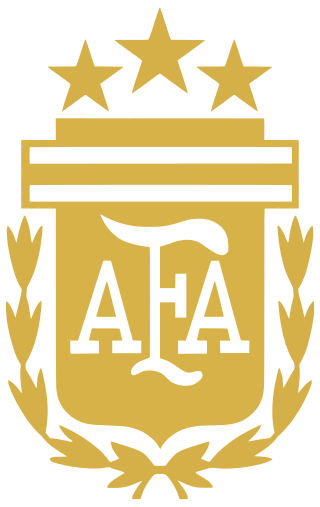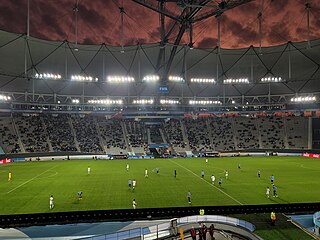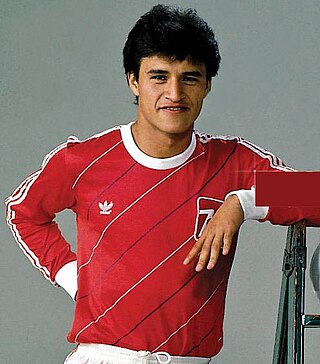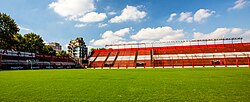
Diego Armando Maradona was an Argentine professional football player and manager. Widely regarded as one of the greatest players in the history of the sport, he was one of the two joint winners of the FIFA Player of the 20th Century award.

Club Atlético Boca Juniors is an Argentine professional sports club based in La Boca, a neighbourhood of Buenos Aires. The club is best known for its professional football team which, since its promotion in 1913, has always played in the Argentine Primera División. The team has won 74 official titles, the most by any Argentine club. National titles won by Boca Juniors include 35 Primera División championships, and 17 domestic cups. Boca Juniors also owns an honorary title awarded by the Argentine Football Association for their successful tour of Europe in 1925.

The Argentina national football team represents Argentina in men's international football and is administered by the Argentine Football Association, the governing body for football in Argentina.

The Alberto José Armando Stadium is a football stadium located in La Boca, Buenos Aires, Argentina. The stadium is widely known as La Bombonera due to its shape, with a "flat" stand on one side of the pitch and three steep stands around the rest of the stadium.

Club Atlético Newell's Old Boys is an Argentine sports club based in Rosario, Santa Fe. The club was founded on 3 November 1903, and is named after Isaac Newell of the English county of Kent, one of the pioneers of Argentine football.

Asociación Atlética Argentinos Juniors is an Argentine sports club based in La Paternal, Buenos Aires. The club is mostly known for its football team, which currently plays in the Argentine Primera División, and was recognized as one of the most important football teams of South America by FIFA. It is one of the eight Argentine first division teams that have won the Copa Libertadores. The continental trophy was won in the club's first entry to the contest, in 1985. The most remarkable sign of this team is the power of its youth teams, which unveiled some of the most talented footballers in Argentine football history, with Diego Maradona as the greatest example of all. As a result, it has been described as "one of Argentina's most distinctive football clubs".

Ricardo Enrique Bochini is an Argentine former professional footballer who played as an attacking midfielder. He is nicknamed El Bocha. His childhood idol was the Brazilian footballer Pelé.

Association football is the most popular sport in Argentina and part of the culture in the country. It is the one with the most players and is the most popular recreational sport, played from childhood into old age. The percentage of Argentines that declare allegiance to an Argentine football club is about 90%.

Estadio Presidente Perón is a stadium in Avellaneda, Greater Buenos Aires, Argentina. More commonly, it is called El Cilindro de Avellaneda. The stadium is the home of Racing Club de Avellaneda.

The Estadio Único Diego Armando Maradona is a multi-purpose stadium located in Tolosa, La Plata Partido, next to the city of La Plata, Argentina. It is also known popularly as the Estadio Único and is owned by Buenos Aires Province, administered jointly by the provincial government, the Municipality of La Plata, and the football clubs Estudiantes de La Plata and Gimnasia y Esgrima de la Plata.
The Olimpia Awards are Argentine sports awards given annually by the Círculo de Periodistas Deportivos since 1954. An Olimpia de Plata is awarded to the outstanding performer in 41 sports.
Diego Maradona stadium can refer to:

Claudio Daniel Borghi Bidos, nicknamed Bichi, is an Argentine naturalized Chilean football manager and former player who played as an attacking midfielder.

New Maradona or New Diego was a title given by the press and public to promising Argentine football players in reference to Diego Maradona as a benchmark. Since Maradona retired, people had been anticipating someone to lead the Argentina national team to a World Cup final, like Maradona did in 1986 and 1990. As a consequence, very talented youngsters were quickly labeled as the New Maradona, sometimes without any similarity in playing style. The New Maradonas were predominantly players in attacking or advanced playmaking roles — forwards, wingers, or attacking midfielders. The term gradually fell out of use after Lionel Messi successfully managed to lead Argentina to World Cup finals in 2014 and 2022, winning it in the latter, arguably emulating and surpassing Maradona to become the most successful Argentine footballer ever.

Carlos Javier Mac Allister is an Argentine politician and former footballer. A centre-back, he played for Argentinos Juniors, Boca Juniors, and Racing Club during his career. He also won three international caps for the Argentina national team in 1993. After his football career, Mac Allister was elected as a National Deputy for the Republican Proposal party in 2023, representing his native province of La Pampa. From 2016 to 2019, he served as Secretary of Sports in the government of President Mauricio Macri.

This is a record of Argentina's results at the FIFA World Cup. Argentina is one of the most successful teams in the tournament's history, having won three World Cups: in 1978, 1986, and 2022. Argentina has also been runner-up three times: in 1930, 1990 and 2014. In 18 World Cup tournaments, Argentina has 47 victories in 88 matches. The team was present in all but four of the World Cups, being behind only Brazil and Germany in number of appearances.
Football is the most popular sport, both in terms of participants and spectators, in the Argentine capital of Buenos Aires. Buenos Aires has one of the highest concentration of football teams of any city in the world, with many of its teams playing in the top tier Primera División. This has led to the development of several rivalries within the city, contested as "derbys" when the regular league schedule brings these teams together, such as the Superclásico between Boca Juniors and River Plate – deemed one of the "50 sporting things you must do before you die" by The Observer. Other major clubs include Vélez Sarsfield, Ferro Carril Oeste and Argentinos Juniors.

The Sistine Chapel of Football is an artwork exhibited at the Sportivo Pereyra club from Barracas in Buenos Aires, Argentina. It honors the two greatest Argentine footballers, Lionel Messi and Diego Maradona, as well as other notable Argentine players including Juan Román Riquelme, Gabriel Batistuta, Mario Kempes, Sergio Agüero, Claudio Caniggia, Ricardo Bochini and Ariel Ortega.
Gregorio "Goyo" Carrizo is an Argentine former footballer and youth coach. He is best known for his close friendship and partnership with Diego Maradona at the Cebollitas youth team in the early 1970s. Carrizo who played as forward is considered one of the greatest talents of all time who did not fulfil their potential and has been dubbed as el otro Maradona due to their football rivalry during childhood.




















